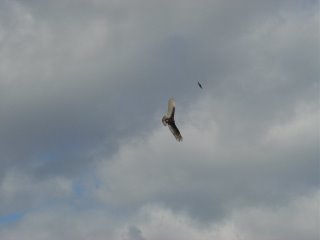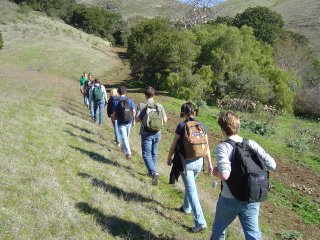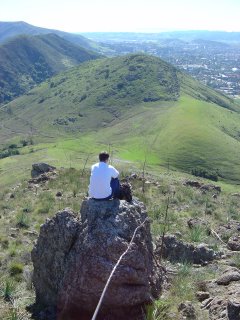Freezing Coastline
As my sister and I started out on the trail, the familiar smell of sweet grass and coastal shrubs filled the air. The only warmth provided was given by the direct light of the sun. The breeze was very cold. The trail winded down through the grass and spilled out on the cliffs, dropping off down to vertical wet shale beneath.
 The wind was whipping up the sides of the cliffs providing the perfect draft for hawk and seagull to ride upon effortlessly.
The wind was whipping up the sides of the cliffs providing the perfect draft for hawk and seagull to ride upon effortlessly. 
As we walked along the cliff's edge and looked out onto the sea, low cumulus clouds cast innumerable shadows on the water, giving the ocean an even more rugged feel. This picture was ever-changing as the wind pushed clouds in and out of the sun's view, making for a very thermally dynamic hike. At the water's edge, creative rock formations channeled water in and out of the area, creating tide pools for some, and providing a source for "anger management" on others where waves were free to crash in any which direction.  One corridor provided a very straight, ever-narrowing route by which the water could travel. Because of its violence upon entry, the white water seemed to be purer than usual. In fact, if taken out of context, it looked as though an avalanche were approaching the shoreline in a perfect tone of white. A very sad and battered log had somehow made its way into this corridor and was stuck underneath some of the rocks at the end of the water's path. It flowed in and out and in again, not really minding the mundane nature of its activity. I doubt if that log will ever find its way out of that gully - it's trapped there by the constant force of white water slamming it against rock and slowly deteriorating it into tiny chunks of bark - death by solitary confinement and torture.
One corridor provided a very straight, ever-narrowing route by which the water could travel. Because of its violence upon entry, the white water seemed to be purer than usual. In fact, if taken out of context, it looked as though an avalanche were approaching the shoreline in a perfect tone of white. A very sad and battered log had somehow made its way into this corridor and was stuck underneath some of the rocks at the end of the water's path. It flowed in and out and in again, not really minding the mundane nature of its activity. I doubt if that log will ever find its way out of that gully - it's trapped there by the constant force of white water slamming it against rock and slowly deteriorating it into tiny chunks of bark - death by solitary confinement and torture.
As I looked up after pointing the log out to my sister, I saw something that made me do a double-take. Could that be snow in the distance? At first it was hard to tell because a few gray clouds were hovering over the top of the distant range, but a short minute later, the clouds retreated, revealing a healthy covering of snow on the coastal range mountains just east of Cambria. 
I did my very best to take pictures of it by changing resolution, aperture values, lighting options, and the above was the very best that I could come up with. A bit difficult to make out, but nevertheless, SNOW! I felt as if I were transported to the Oregon or Washington coastline for a moment, and enjoyed the unique sight.
More hawks and gulls danced along the updrafts as I meandered back to my car, looking back every minute or two to make sure that the snow was still there.



